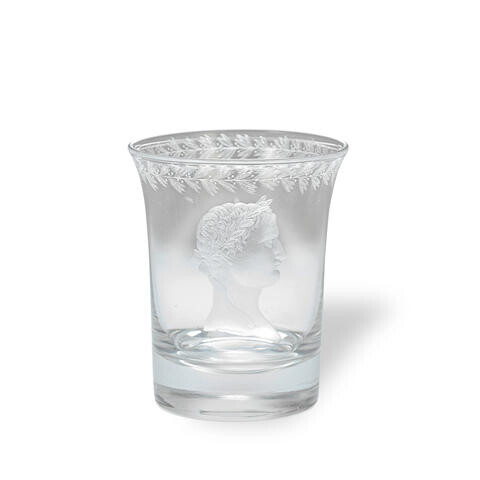A very rare Paris engraved glass portrait beaker by Broussouze, circa 1810
Of so-called 'Charpentier' type, the cylindrical form with a flared rim, finely decorated with a profile portrait of Napoleon Bonaparte after Galle, the Emperor facing dexter and wearing a laurel wreath, signed 'BROUSSOUZE', the rim with a formal foliate border, 9.4cm high
Glasses of this form produced during the Empire period are traditionally referred to as 'Charpentier glasses' after a certain Charpentier, whose name and Parisian address were discovered on a label inside the cover of the case of a related beaker in the Museum Kunstpalast, Düsseldorf (inv. no. mkp.P 1940-189). See Walter Spiegel, 'Pariser Glasschnitt im Empire: Die so genannten Charpentier-Gläser', Die Kunst (5/1987), p.393 for a discussion. 'Charpentier glasses' are found in three general forms: cylindrical, bell-shaped, and that of the present lot.
We know relatively little about the identity of Broussouze, other than he was established in Paris at 150 Rue Montmartre from 1808, and at 137 Galerie de Pierre in the Palais-Royale from 1810. A signed beaker engraved with a profile portrait of Louis XVIII by Broussouze with an identical foliate border, dated to circa 1814-20, is illustrated and discussed by Fernando Montes de Oca, L'Age D'Or du Verre en France (2001), pp.181-3, no.149. The same beaker is also illustrated by Brigitte Baumgärtner, Porträtgläser (1981), p.49, fig.54. This beaker is mentioned together with the present lot by Spiegel (ibid.) at p.396.
It is possible the Parisian glass engravers such as Broussouze were influenced by contemporary Bohemian engravers, but the quality of French engraving of this period is generally softer and more painterly. The profile of Napoleon's nose on the present lot, which is slightly more 'Roman' than usually seen, together with the bow to the back of the laurel wreath, suggest that the portrait is taken from the medal struck in 1805 by André Galle rather than the virtually identical medal struck in 1804 by Bertrand Andrieu.
View it on
Sale price
Estimate
Time, Location
Auction House
Of so-called 'Charpentier' type, the cylindrical form with a flared rim, finely decorated with a profile portrait of Napoleon Bonaparte after Galle, the Emperor facing dexter and wearing a laurel wreath, signed 'BROUSSOUZE', the rim with a formal foliate border, 9.4cm high
Glasses of this form produced during the Empire period are traditionally referred to as 'Charpentier glasses' after a certain Charpentier, whose name and Parisian address were discovered on a label inside the cover of the case of a related beaker in the Museum Kunstpalast, Düsseldorf (inv. no. mkp.P 1940-189). See Walter Spiegel, 'Pariser Glasschnitt im Empire: Die so genannten Charpentier-Gläser', Die Kunst (5/1987), p.393 for a discussion. 'Charpentier glasses' are found in three general forms: cylindrical, bell-shaped, and that of the present lot.
We know relatively little about the identity of Broussouze, other than he was established in Paris at 150 Rue Montmartre from 1808, and at 137 Galerie de Pierre in the Palais-Royale from 1810. A signed beaker engraved with a profile portrait of Louis XVIII by Broussouze with an identical foliate border, dated to circa 1814-20, is illustrated and discussed by Fernando Montes de Oca, L'Age D'Or du Verre en France (2001), pp.181-3, no.149. The same beaker is also illustrated by Brigitte Baumgärtner, Porträtgläser (1981), p.49, fig.54. This beaker is mentioned together with the present lot by Spiegel (ibid.) at p.396.
It is possible the Parisian glass engravers such as Broussouze were influenced by contemporary Bohemian engravers, but the quality of French engraving of this period is generally softer and more painterly. The profile of Napoleon's nose on the present lot, which is slightly more 'Roman' than usually seen, together with the bow to the back of the laurel wreath, suggest that the portrait is taken from the medal struck in 1805 by André Galle rather than the virtually identical medal struck in 1804 by Bertrand Andrieu.



